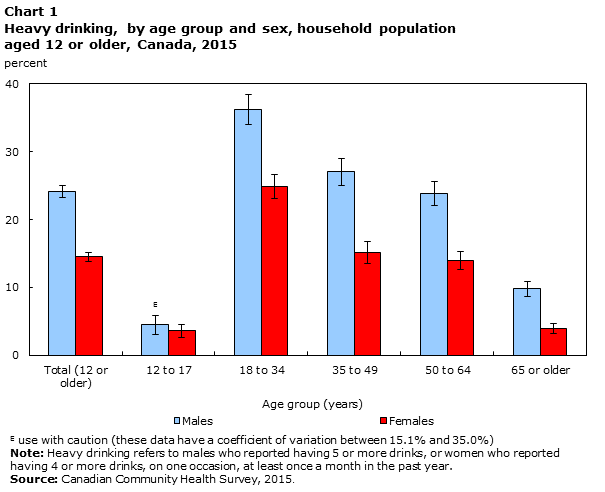Health Fact Sheets
Heavy drinking, 2015
Archived Content
Information identified as archived is provided for reference, research or recordkeeping purposes. It is not subject to the Government of Canada Web Standards and has not been altered or updated since it was archived. Please "contact us" to request a format other than those available.
Correction Notice
On October 19, 2017, the estimate of Canadians who were at risk due to their past week alcohol consumption was revised. The estimates were originally 74.0% for heavy drinkers and 54.0% for non-heavy drinkers. After correcting an error, the estimates are 58.4% and 6.7%, respectively.
The estimate of Canadian youth who drank alcoholic beverages in the past 12 months was also revised. The estimate was originally 74.9%, but this estimate excluded those who had not drank alcohol in their life. If all youth are included, the correct estimate is 27.0%.
In 2015, 19.2% of Canadians aged 12 and older, or roughly 5.8 million people, reported alcohol consumption that classified them as heavy drinkers.Note 1 Overall, males were more likely (24.1%) to report heavy drinking than females (14.5%) in 2015.Note 2
The highest proportion of heavy drinking for both sexes was among those aged 18 to 34. In this age group, 36.2% of males and 24.9% of females were heavy drinkers (Chart 1).

Data table for Chart 1
| Age group (years) | Percent | Confidence Interval | |
|---|---|---|---|
| Lower 95% | Upper 95% | ||
| Males | |||
| Total (12 or older) | 24.1 | 23.2 | 24.9 |
| 12 to 17 | 4.5Note E: Use with caution | 3.1 | 6.0 |
| 20 to 34 | 36.2 | 34.0 | 38.4 |
| 35 to 49 | 27.0 | 25.0 | 29.0 |
| 50 to 64 | 23.8 | 22.0 | 25.5 |
| 65 or older | 9.8 | 8.7 | 10.9 |
| Females | |||
| Total (12 or older) | 14.5 | 13.8 | 15.2 |
| 12 to 17 | 3.6 | 2.6 | 4.6 |
| 20 to 34 | 24.9 | 23.1 | 26.7 |
| 35 to 49 | 15.1 | 13.5 | 16.6 |
| 50 to 64 | 14.0 | 12.7 | 15.4 |
| 65 or older | 4.0 | 3.3 | 4.7 |
|
E use with caution Note: Heavy drinking refers to males who reported having 5 or more drinks, or women who reported having 4 or more drinks, on one occasion, at least once a month in the past year. Source: Canadian Community Health Survey, 2015. |
|||
Given that it is illegal to sell alcohol to anyone under 18 in Canada,Note 3Note 4 the amount of heavy drinking among 12 to 17 year olds is expectedly low (4.1%). Despite the laws that prevent underage drinking, youth are still able to consume alcoholic beverages. In 2015, 27.0% of Canadian youth drank an alcoholic beverage in the previous 12 months and 40.8% of them did so at least once a month.
The proportion of residents who reported heavy drinking was lower than the national average (19.2%) in British Columbia (17.3%).
The proportion of residents who reported heavy drinking was higher than the national average in:
- Newfoundland and Labrador (25.6%)
- Quebec (20.2%)
- Saskatchewan (21.7%)
The proportion of residents who reported heavy drinking was the same as the national average in the other provinces.
The 2015 Canadian Community Health Survey also included questions on alcohol use during the last week. Of the 5.8 million heavy drinkers in 2015, 58.4% reported a level of alcohol consumption in the last week that put their long term health at risk. Among Canadians who were not heavy drinkers, 6.7% reported a level of consumption in the last week that poses long term risks. On average, Canadians who were classified as heavy drinkers had 9.8 drinks in the past week, compared to non-heavy drinkers who consumed 1.6 drinks.
Start of text box
About heavy drinking
Excessive alcohol consumption can have serious health and social consequences, especially when combined with other behaviours such as driving while intoxicated. For males, heavy drinking refers to having consumed five or more drinks, per occasion, at least once a month during the past year. For females, heavy drinking refers to having consumed four or more drinks, per occasion, at least once a month during the past year.
According to Canada’s Low-Risk Alcohol Drinking Guidelines, long term risks for alcohol consumption are liver disease and certain cancers. Males are classified at risk if they had more than 15 drinks in the week of reporting or at least one day with 4 or more drinks. Females are classified at risk if they had more than 10 drinks in the week of reporting or at least one day with 3 or more drinks.
End of text box
References
Hindmarch I., J. Bhatti, G. Starmer, D. Mascord, J. Kerr, and N. Sherwood. 1992. “The effects of alcohol on the cognitive function of males and females and on skills relating to car driving.” Human Psychopharmacology: Clinical & Experimental. Vol.7, no. 2.
Hotton, T., and D. Haans. 2004. “Alcohol and drug use in early adolescence.” Health Reports. Statistics Canada Catalogue no. 82-003. Vol. 15, no. 3. (Accessed January 11th, 2017)
Pérez, C. 2005. “Passengers of intoxicated drivers.” Health Reports. Statistics Canada Catalogue no. 82-003. Vol. 16, no. 2. (Accessed January 11th, 2017)
Tjepkema, M. 2004. “Alcohol and illicit drug dependence.” Health Reports. Statistics Canada Catalogue no. 82-003. Vol. 15 (Supplement). (Accessed January 11th, 2017)
Wilkins, K. 2002. “Moderate alcohol consumption and heart disease.” Health Reports. Statistics Canada Catalogue no. 82-003. Vol. 14, no. 1. (Accessed January 11th, 2017)
Data
Additional data from the Canadian Community Health Survey are available from CANSIM table 105–0508.- Date modified:

